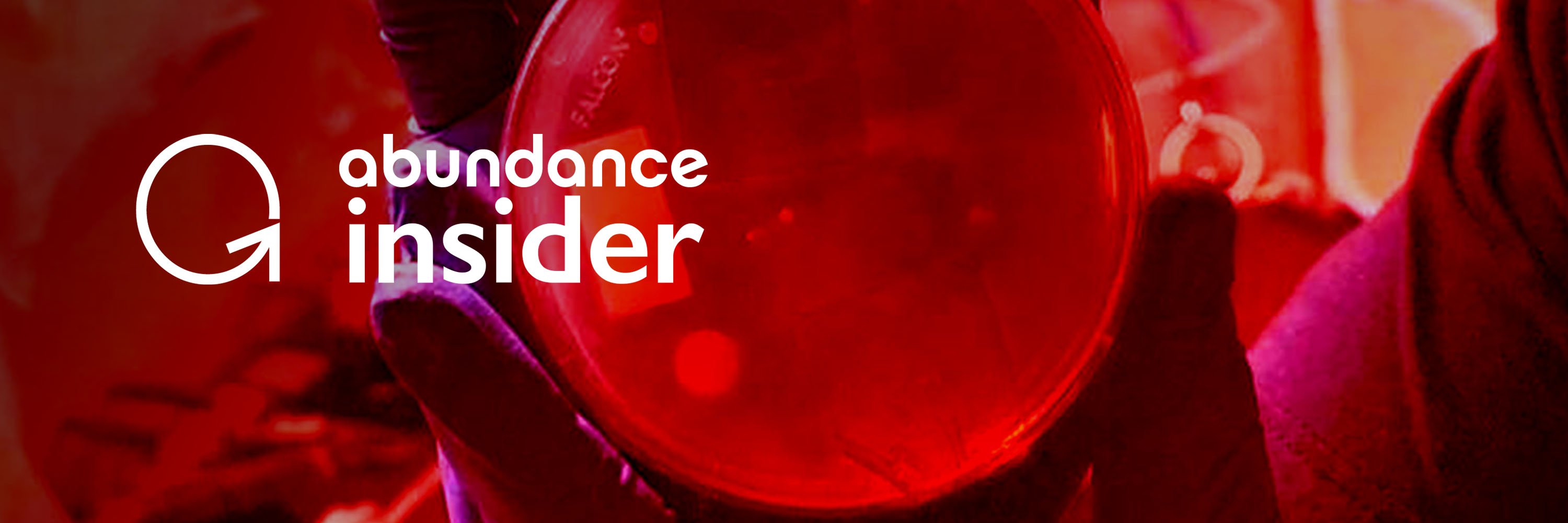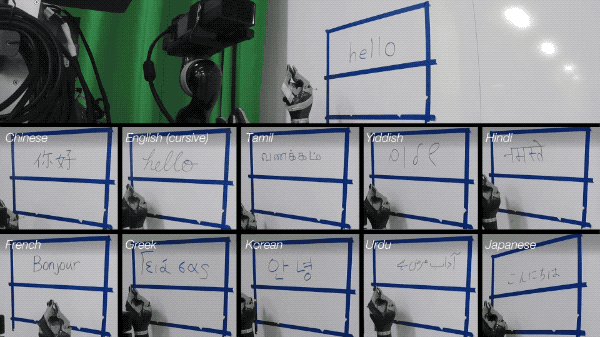
In this week's Abundance Insider: Self-driving USPS trucks, CRISPR in space, and multilingual robot writers.
Cheers,
Peter, Marissa, Kelley, Greg, Bri, Jarom, Joseph, Derek, Jason, Claire, Max and Nora
P.S. Send any tips to our team by clicking here, and send your friends and family to this link to subscribe to Abundance Insider.
P.P.S. Want to learn more about exponential technologies and hone in on your MTP/ Moonshot? Abundance Digital, a Singularity University Program, includes 100+ hours of course work and video archives for entrepreneurs, like you. Keep up to date on exponential news and get feedback on your boldest ideas from an experienced, supportive community. Click here to learn more and sign up.
This Crafty Robot Can Write In Languages It’s Never Seen Before

What it is: Researchers at Brown University have trained a robot to hand-write words in multiple languages, deducing stroke order from countless handwritten scripts. First, the learning system’s “local” model determines characteristics of the stroke at hand (think direction or ending). Next, a “global” model takes charge of moving the robot’s writing utensil from stroke to stroke. Initially trained using a set of Japanese characters, the robot’s deep learning algorithm achieved a 93 percent accuracy rate in reproducing characters and individual stroke order. Remarkably, however, the robot was then able to apply these same skills to numerous other characters — cursive English, Urdu, Greek, Chinese, Yiddish — learning stroke order from scratch.
Why it's important: In the past, robots have needed detailed information about stroke order to replicate handwritten script. Now, however, as assistant professor and project advisor Stefanie Tellex explains, “you can draw whatever you want and the robot can reproduce it,” whether a kindergartener’s handwriting or a whiteboard drawing of the Mona Lisa. While still far off, this marks a tremendous leap forward in carving new methods of communication between humans and machines. We might even imagine a use case in which robots could help us store thousands of dead and dying languages, or write for us in our own handwriting style. | Share on Facebook
Spotted by Marissa Brassfield / Written by Claire Adair
Samsung’s New A.I. Software Makes Generating Fake Videos Even Easier

What it is: Samsung’s Artificial Intelligence center in Moscow has released a new algorithm capable of creating generate fake talking-head videos with just a few images of a person’s face. Many recent works, including the recent fake of Nancy Pelosi, have used Convolutional Neural Networks (CNN’s) to achieve their realism, but those have required a large amount of data to train the algorithms. Here, Egor Zakharov and colleagues have created a system capable of doing the same with just a few images of a previously unseen person. The system is first trained on a large dataset of videos in order to meta-learn facial profiles and create an adversarial training problem. From just a few images of a person, the system is then able to initialize a generative adversarial network (GAN) in a person-specific way.
Why it's important: The authors address the potential for abuse by noting that Hollywood has been creating fake videos for decades via special effects; this type of technology is merely democratizing special effects. Look for its use to increase in news as well as in entertainment. Importantly, as trust in video trust as a source of truth declines, consider how you can engender trust in your own brand or brands as a competitive advantage. | Share on Facebook
Spotted by Claire Adair / Written by Jason Goodwin
Self-Driving Trucks Begin Mail Delivery Test For U.S. Postal Service
What it is: The U.S. Postal Service (USPS) started a two-week trial of using autonomous cars to transport mail across state lines. Through a partnership with autonomous truck startup TuSimple, USPS will send an autonomous truck (accompanied by a safety driver) on five round trips from Dallas and Phoenix, each totaling over 2,100 miles and 45 hours of driving.
Why it's important: Autonomous cars are here to stay. A popular misconception is that all autonomous vehicles will cause massive labor shortages for the 3.5 million truck drivers in the U.S. On the contrary, this initiative comes as shippers and freight haulers face a worsening driver shortage, with the American Trucking Association estimating a shortage of 174,500 drivers by 2024. The world’s greatest problems are truly the greatest opportunities for innovation and acceleration. | Share on Facebook
Spotted by Max Goldberg / Written by Max Goldberg
Microsoft's Latest Text-To-Speech AI Generates Realistic Speech

What it is: Following Google’s Translatotron and Amazon’s Polly, Microsoft just released its own Text to Speech (TTS) generator. To date, most works involving TTS and automatic speech recognition have been developed separately, with largely incompatible methods. In partnership with Chinese researchers, Microsoft created an almost-unsupervised learning method that combined text and speech data into a unified model, leading to a large jump in word accuracy and intelligibility.
Why it's important: As good as AI systems have become, we continue to see new methods that either reduce the amount of data required for training, or greatly improve the accuracy of systems. As the authors have done here, how might you combine diverse systems to exponentially improve results in your own projects? | Share on Facebook
Spotted by Marissa Brassfield / Written by Jason Goodwin
Algorithm Predicts Patient Survival In Intensive Care

What it is: Leveraging the Danish National Patient Registry, researchers in Denmark have now honed an algorithm that predicts patients’ chances of survival in the intensive care unit (ICU). To refine the algorithm, researchers aggregated data on over 230,000 patients admitted to ICUs in Denmark between 2004 and 2016. As their system draws on the disease history of each individual patient under treatment, the algorithm can now make unprecedentedly accurate calculations regarding a patient’s risk of dying in hospital within 30 or 90 days of admission. With up to 23 years of individual disease records, the algorithm has even begun to analyze the weight of various parameters in the likelihood of survival.
Why it's important: Medical practitioners have long struggled to consistently determine which treatments are best suited for each patient in intensive care. As explained by professor and co-author Anders Perner, “Excessive treatment is a serious risk among terminally ill patients,” and “doctors and nurses have lacked a support tool capable of instructing them on who will benefit from intensive care.” Now, not only does this algorithm accurately personalize risk calculations for each ICU patient, but it can help us understand which factors are most vital for intensive care patients. As predictions are increasingly fine-tuned, algorithms could one day crunch decades of data in minutes for groundbreakingly accurate, personalized prognoses. | Share on Facebook
Spotted by Marissa Brassfield / Written by Claire Adair
Astronauts Use CRISPR In Space For The First Time Ever

What it is: For the first time, astronauts aboard the International Space Station used CRISPR to modify a genome in space. Christina Koch and Nick Hague used CRISPR to edit a yeast genome to mimic radiation-caused damage to DNA. CRISPR experiments like this one could provide critical information to helping humans live in the radiation intense environment of space.
Why it's important: CRISPR gene editing in space represents another true and transformative convergence. With the oncoming demonetization of human space flight, biotech tools like CRISPR will enable humans to live and thrive in outer space. What other exponential technologies will augment our ability to thrive in extraterrestrial environments? | Share on Facebook
Spotted by Marissa Brassfield / Written by Max Goldberg
What is Abundance Insider?
This email is a briefing of the week's most compelling, abundance-enabling tech developments, curated by Marissa Brassfield in preparation for Abundance 360. Read more about A360 below.
Want more conversations like this?
At Abundance 360, a Singularity University Program, we teach the metatrends, implications and unfair advantages for entrepreneurs enabled by breakthroughs like those featured above. We're looking for CEOs and entrepreneurs who want to change the world. The program is highly selective. If you'd like to be considered, apply here.
Abundance Digital, a Singularity University Program, is an online educational portal and community of abundance-minded entrepreneurs. You’ll find weekly video updates from Peter, a curated newsfeed of exponential news, and a place to share your bold ideas. Click here to learn more and sign up.
Know someone who would benefit from getting Abundance Insider? Send them to this link to sign up.
Topics: Abundance Insider Space Robotics Transportation health Artificial Intellegence robots autonomous vehicles self-driving cars biotech








